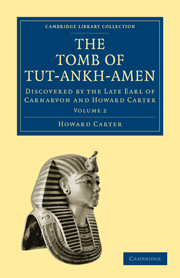Book contents
- Frontmatter
- PREFACE
- Contents
- LIST OF PLATES
- INTRODUCTION. REMARKS UPON EGYPTIAN ART
- CHAPTER 1 TUT-ANKH-AMEN
- CHAPTER 2 THE TOMB AND BURIAL CHAMBER
- CHAPTER 3 CLEARING THE BURIAL CHAMBER AND OPENING THE SARCOPHAGUS
- CHAPTER 4 THE STATE CHARIOTS
- CHAPTER 5 THE OPENING OF THE THREE COFFINS (SEASON 1925–26)
- CHAPTER 6 POINTS OF INTEREST IN EGYPTIAN BURIAL CUSTOMS
- CHAPTER 7 THE EXAMINATION OF THE ROYAL MUMMY
- APPENDICES
- APPENDIX I REPORT UPON THE EXAMINATION OF TUT-ANKH-AMEN'S MUMMY
- APPENDIX II THE CHEMISTRY OF THE TOMB
- APPENDIX III REPORT ON THE FLORAL WREATHS FOUND IN THE COFFINS OF TUT-ANKH-AMEN
- APPENDIX IV NOTES ON OBJECTS FROM THE TOMB
- APPENDIX V REPORT ON THE EXAMINATION OF SPECIMENS FROM THE TOMB OF KING TUT-ANKH-AMEN
- APPENDIX VI DESCRIPTION OF THE OBJECTS. PLATES XXXVII-LXXXVIII
- INDEX
- Plate section
- Plate section
APPENDIX IV - NOTES ON OBJECTS FROM THE TOMB
Published online by Cambridge University Press: 05 March 2012
- Frontmatter
- PREFACE
- Contents
- LIST OF PLATES
- INTRODUCTION. REMARKS UPON EGYPTIAN ART
- CHAPTER 1 TUT-ANKH-AMEN
- CHAPTER 2 THE TOMB AND BURIAL CHAMBER
- CHAPTER 3 CLEARING THE BURIAL CHAMBER AND OPENING THE SARCOPHAGUS
- CHAPTER 4 THE STATE CHARIOTS
- CHAPTER 5 THE OPENING OF THE THREE COFFINS (SEASON 1925–26)
- CHAPTER 6 POINTS OF INTEREST IN EGYPTIAN BURIAL CUSTOMS
- CHAPTER 7 THE EXAMINATION OF THE ROYAL MUMMY
- APPENDICES
- APPENDIX I REPORT UPON THE EXAMINATION OF TUT-ANKH-AMEN'S MUMMY
- APPENDIX II THE CHEMISTRY OF THE TOMB
- APPENDIX III REPORT ON THE FLORAL WREATHS FOUND IN THE COFFINS OF TUT-ANKH-AMEN
- APPENDIX IV NOTES ON OBJECTS FROM THE TOMB
- APPENDIX V REPORT ON THE EXAMINATION OF SPECIMENS FROM THE TOMB OF KING TUT-ANKH-AMEN
- APPENDIX VI DESCRIPTION OF THE OBJECTS. PLATES XXXVII-LXXXVIII
- INDEX
- Plate section
- Plate section
Summary
The following notes relating to objects in and from the tomb of King Tut-ankh-Amen may prove of interest, and are supplementary to the more systematic report of Mr. A. Lucas. Some of the experiments were made on the spot in January, 1924, with only very rudimentary chemical apparatus, and minute quantities of material.
A. The Pall and other Textile Fabrics. The fabric of the pall which was within the outer shrine, but which covered the second shrine, was very frail yet possessed quite enough strength to withstand weak tensile strains such as would be involved in attempting to wind it on a roller. To render it strong enough to stand any kind of manipulation beyond this it seemed essential to strengthen the threads with some flexible material which would bind the fibres together. Various solutions were tried which, from their known properties, seemed likely to prove suitable for this purpose. The most promising were:
I. “Duroprene”. This, as sold, is too viscous to admit of ready application and is not readily or rapidly absorbed. When this was diluted with an equal volume of xylol and this solution applied to the fabric with a soft brush and then dried, the desired result seems to have been attained at once. Although the interstices of the fabric were completely filled up when the solution was applied, on drying, these connecting films of liquid—dried in such a manner that all the dissolved matter was left in the threads so that no glistening films showed anywhere—the fabric looked practically unchanged in colour and structure.
- Type
- Chapter
- Information
- The Tomb of Tut-Ankh-AmenDiscovered by the Late Earl of Carnarvon and Howard Carter, pp. 197 - 213Publisher: Cambridge University PressPrint publication year: 2010First published in: 1927



